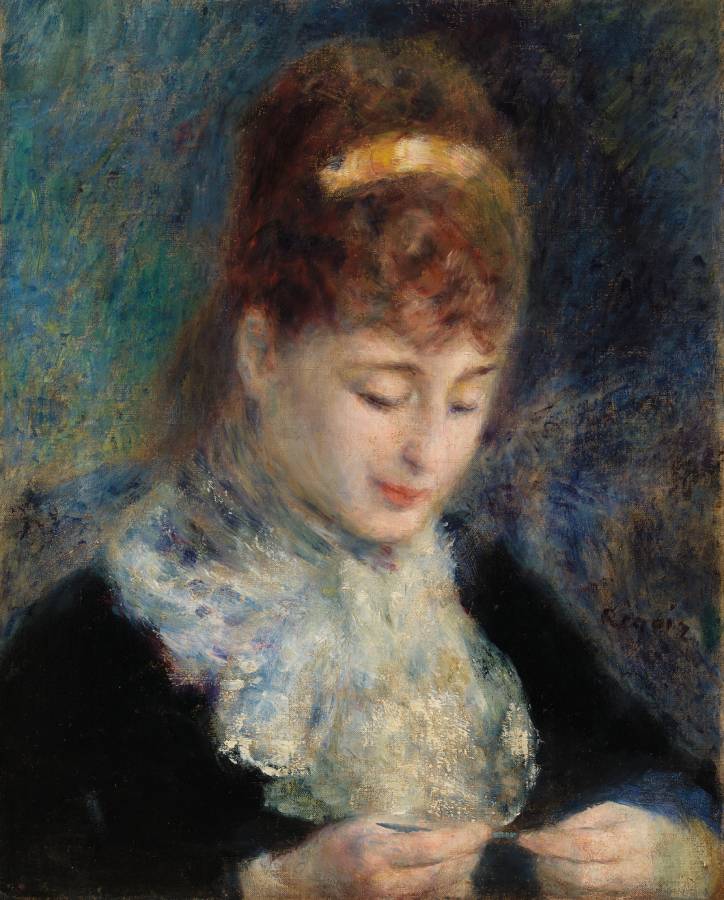Renoir, Pierre-Auguste (1841-1919)
Femme faisant du crochet (Woman Crocheting)
c.1877
Oil on canvas, 41 x 32.5 cm
Barnes Foundation, Philadelphia
During the 1870s, alongside his ambitious modern life subjects such as Leaving the Conservatory (BF862), Renoir painted very many canvases of single figures; some of these were portraits, but many were more generic, showing unidentified figures, generally bust length, focusing on their everyday activities. Woman Crocheting is one of the most elaborated and highly finished of these canvases; despite its small scale, its treatment and signature show that Renoir intended it for sale, and it seems likely that the composer Emmanuel Chabrier, who also owned Leaving the Conservatory, acquired it soon after its execution, though we do not know when.
In some of these single-figure paintings, the model is depicted informally dressed or revealingly posed in her undergarments, as in A Girl Crocheting of circa 1875. Here, by contrast, there is no such sensual appeal; the figure is fully and fashionably dressed, with an elaborate lace scarf, as she focuses on her crocheting. Her hair is held in place by a gold-colored hairband, and her lowered eyes deny the viewer any imaginative access toter expression. Indeed, of all Renoir‘s paintings of a single female figure, this is one of those that makes the least direct appeal to the viewer, in either empathetic or voyeuristic terms.
Her facial features are treated with considerable delicacy but wholly without conventional draftsmanship. The lit side of her face is differentiated from the background by contrasts of color and tone, but its contours are soft, and the shadowed side of her head is gently blurred into the wall behind her. Alongside the pink of her face and hands and the red of her lips, her golden hairband and especially her light scarf act as focal points, set off against the darker hues of the rest of the picture. The ruff is handled with great freedom, in an array of variegated and seemingly spontaneous touches that hint at its form and fabric but wholly without descriptive detail. We cannot be certain, too, about the ruff’s actual, local color; its highlights are white and pale cream, but much soft blue is used to suggest the fall of its material and the shadows in it. We are likewise left uncertain about the color of the model’s hair, which is treated with varied strokes of red and blue and, on its lit side, soft yellows.
The background does not merely act as a foil to the figure. It is delicately brushed, in fine strokes predominantly of blue and green with some soft yellow accents. However, despite the finesse of its execution, it is unclear what it represents. The more emphatic strokes to the lower right of the figure may suggest a sofa on which she is seated, but the area behind her head might be read as a wall covering or as some sort of foliage. In the treatment of areas such as these, Renoir was more concerned with integrating the background into the complex overall color-harmony of the canvas as a whole than with creating a legible illusionistic space.
In broad terms, figures such as these carry echoes of the art of the French 18th century, for which Renoir held a lifelong interest; the small canvases of half-length female figures by Jean-Honoré Fragonard and Jean-Baptiste Greuze seem especially relevant to canvases such as Woman Crocheting, though Renoir studiously avoided the sentimental and moral undertones that characterize Greuze’s figures in particular.
John House, Renoir in the Barnes Foundation (New Haven: Yale University Press, 2012), 91. (BF)
